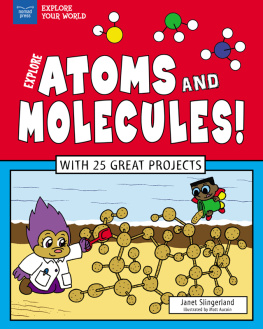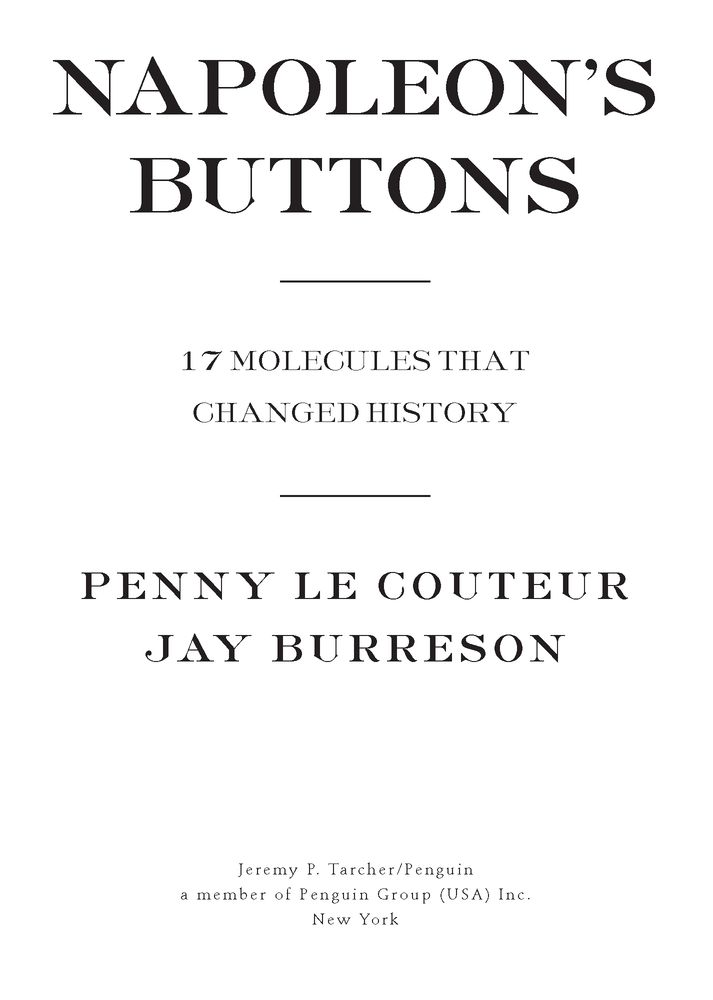Table of Contents
FOR OUR FAMILIES
INTRODUCTION
For the want of a nail the shoe was lost.
For the want of a shoe the horse was lost.
For the want of a horse the rider was lost.
For the want of a rider the battle was lost.
For the want of a battle the kingdom was lost.
And all for the want of a horse-shoe nail.
OLD ENGLISH NURSERY RHYME
IN JUNE 1812, Napoleons army was 600,000 strong. By early December, however, the once proud Grande Arme numbered fewer than 10,000. The tattered remnants of Napoleons forces had crossed the Berezina River, near Borisov in western Russia, on the long road of retreat from Moscow. The remaining soldiers faced starvation, disease, and numbing coldthe same enemies that had defeated their comrades as surely as had the Russian army. More of them were to perish, ill clad and ill equipped to survive the bitter cold of a Russian winter.
Napoleons retreat from Moscow had far-reaching consequences on the map of Europe. In 1812, 90 percent of the Russian population consisted of serfs, the outright property of a landowner, bought, sold, or traded at whim, a situation closer to slavery than serfdom ever was in western Europe. The principles and ideals of the French Revolution of 1789-1799 had followed Napoleons conquering army, breaking down the medieval order of society, changing political boundaries, and fomenting the concept of nationalism. His legacy was also practical. Common civil administration and legal codes replaced the widely varying and confusing system of regional laws and regulations, and new concepts of individual, family, and property rights were introduced. The decimal system of weights and measures became the standard instead of the chaos of hundreds of different local scales.
What caused the downfall of the greatest army Napoleon had led? Why did Napoleons soldiers, victorious in previous battles, falter in the Russian campaign? One of the strangest theories to be advanced can be captured by paraphrasing an old nursery rhyme: all for the want of a button. Surprising as it may seem, the disintegration of Napoleons army may be traceable to something as small as the disintegration of a buttona tin button, to be exact, the kind that fastened everything from the greatcoats of Napoleons officers to the trousers and jackets of his foot soldiers. When temperatures drop, shiny metallic tin starts to change into a crumbly nonmetallic gray powderstill tin, but with a different structural form. Is this what happened to the tin buttons of Napoleons army? At Borisov one observer described Napoleons army as a mob of ghosts draped in womens cloaks, odd pieces of carpet or greatcoats burned full of holes. Were Napoleons men, as the buttons on their uniforms fell apart, so weakened by the chilling cold they could no longer function as soldiers? Did the lack of buttons mean that hands were used to hold garments together rather than carry weapons?
There are numerous problems in determining the veracity of this theory. Tin disease, as the problem was called, had been known in northern Europe for centuries. Why would Napoleon, a great believer in keeping his troops fit for battle, have permitted its use in their garments? And the disintegration of tin is a reasonably slow process, even at the very low temperatures of the 1812 Russian winter. It makes a good story, though, and chemists enjoy quoting it as a chemical reason for Napoleons defeat. And if there is some truth to the tin theory, then one has to wonder whether, if tin did not deteriorate in the cold, the French might have continued their eastward expansion. Would the yoke of serfdom have been lifted from the Russian people half a century earlier than it was? Would the distinction between western and eastern Europe, which roughly parallels the extent of Napoleons empirea testament to his lasting influencestill be apparent today?
Throughout history metals have been pivotal in shaping human events. Apart from its possibly apocryphal role in Napoleons buttons, tin from the Cornish mines in southern England was highly sought after by the Romans and was one reason for the extension of the Roman Empire into Britain. By 1650 an estimated sixteen thousand tons of silver from the mines of the New World had enriched the coffers of Spain and Portugal, much of it to be used supporting wars in Europe. The search for gold and silver had an immense impact on exploration, settlement, and the environment of many regions; for example, the gold rushes of the nineteenth century in California, Australia, South Africa, New Zealand, and the Canadian Klondike did much to open up those countries. As well, our language contains many words or phrases invoking this metalgoldbrick, gold standard, good as gold, golden years. Whole epochs have been named in tribute to the importance of metals. The Bronze Age, when bronzean alloy or mixture of tin and copperwas used for weapons and tools was followed by the Iron Age, characterized by smelting of iron and the use of iron implements.
But is it only metals like tin and gold and iron that have shaped history? Metals are elementssubstances that cannot be decomposed into simpler materials by chemical reactions. There are only ninety naturally occurring elements, and tiny amounts of another nineteen or so have been made by man. But there are about seven million compounds, substances formed from two or more elements, chemically combined in fixed proportions. Surely there must be compounds that have also been pivotal in history, compounds without which the development of human civilization would have been very different, compounds that changed the course of world events. Its an intriguing idea, and it is the principal unifying theme underlying each chapter of this book.
In looking at some common and not-so-common compounds from this different perspective, fascinating stories emerge. In the Treaty of Breda of 1667 the Dutch ceded their only North American possession in exchange for the small island of Run, an atoll in the Banda Islands, a tiny group in the Moluccas (or Spice Islands), east of Java in present-day Indonesia. The other signatory nation to this treaty, England, gave up its legitimate claim to Runwhose only asset was its groves of nutmeg treesto gain the rights to another small piece of land halfway around the world, the island of Manhattan.
The Dutch had staked their claim to Manhattan shortly after Henry Hudson, seeking a Northwest Passage to the East Indies and the fabled Spice Islands, visited the area. In 1664 the Dutch governor of New Amsterdam, Peter Stuyvesant, was forced to surrender the colony to the English. Protests by the Dutch over this seizure and other territorial claims kept the two nations at war for nearly three years. English sovereignty over Run had angered the Dutch, whose monopoly of the nutmeg trade needed only the island of Run to be complete. The Dutch, with a long history of brutal colonization, massacres, and enslavement in the region, were not about to allow the English to keep a toehold in this lucrative spice trade. After a four-year siege and much bloody fighting, the Dutch invaded Run. The English retaliated by attacking the richly laden ships of the Dutch East India Company.
The Dutch wanted compensation for English piracy and the return of New Amsterdam; the English demanded payment for the Dutch outrages in the East Indies and the return of Run. With neither side about to back down nor able to claim victory in the sea battles, the Treaty of Breda offered a face-saving opportunity for both sides. The English would keep Manhattan in return for giving up their claims to Run. The Dutch would retain Run and forgo further demands for Manhattan. As the English flag was raised over New Amsterdam (renamed New York), it seemed that the Dutch had got the better part of the deal. Few could see the worth of a small New World settlement of about a thousand people compared to the immense value of the nutmeg trade.








